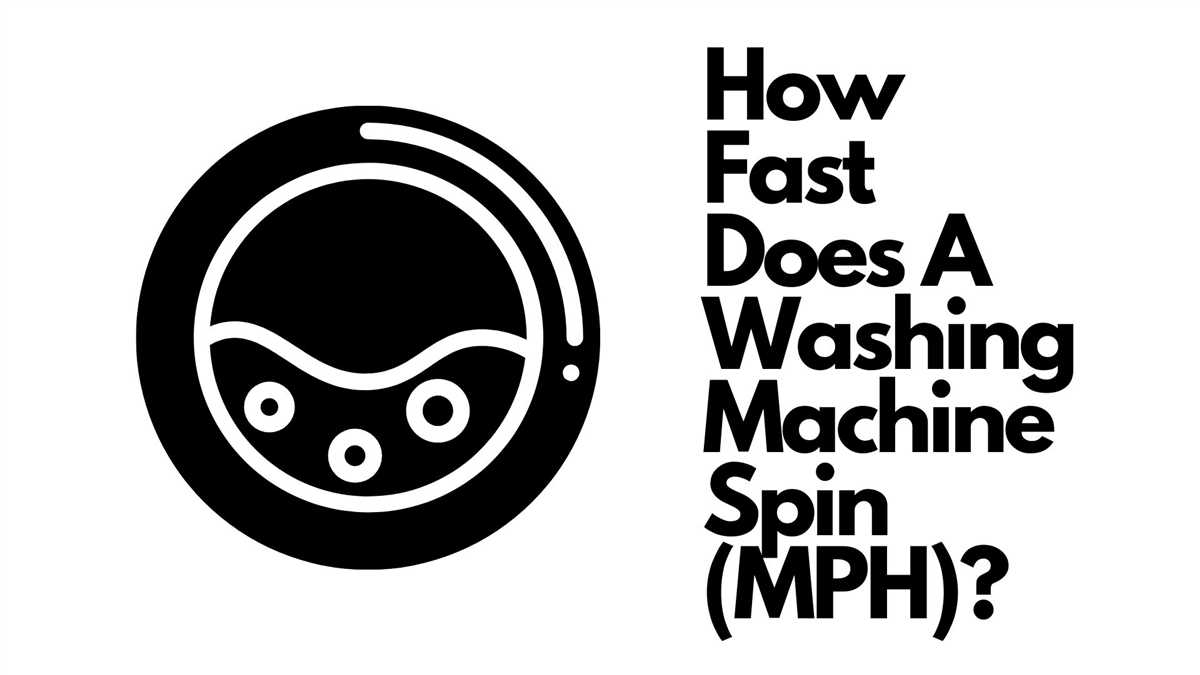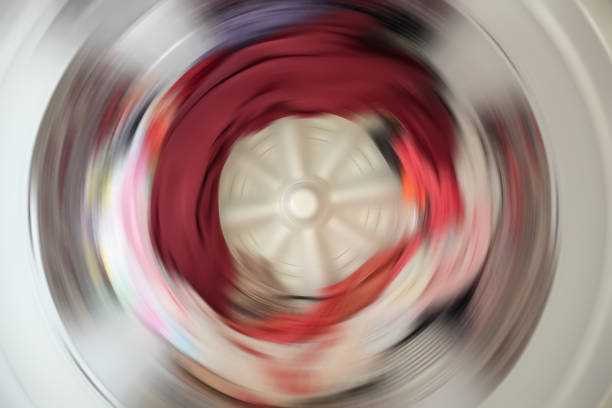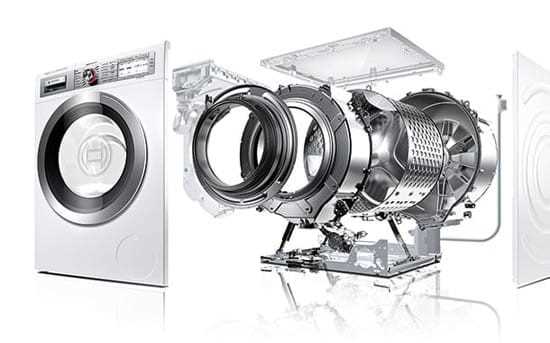




When it comes to washing machines, one important factor that you may not have considered is the speed of the spin cycle. The spin speed is measured in revolutions per minute (rpm), but have you ever wondered what that actually means in terms of miles per hour (mph)? In this article, we will explore the speed of washing machine spin cycles in mph and why it matters for your laundry.
Why does spin speed matter?
Spin speed plays a crucial role in how well your washing machine can remove water from your clothes. The faster the spin cycle, the more centrifugal force is generated, which helps to wring out excess water. This means that your clothes will come out of the washing machine drier, which will result in shorter drying times and potentially even energy savings.
However, it’s important to note that not all fabrics can handle high spin speeds. Delicate fabrics, such as silk or wool, may be damaged if spun too fast. Additionally, larger loads may not be able to handle high spin speeds as well, as the increased force can cause the drum to become unbalanced, leading to excessive vibration and potential damage to the machine.
“The spin speed is measured in revolutions per minute (rpm), but have you ever wondered what that actually means in terms of miles per hour (mph)? In this article, we will explore the speed of washing machine spin cycles in mph and why it matters for your laundry.”
How to determine the mph of your washing machine’s spin speed?
To determine the mph of your washing machine’s spin speed, you can use a simple conversion formula. First, take the rpm of the spin speed and multiply it by the circumference of the drum. Then, divide that number by 5,280 (the number of feet in a mile) and multiply by 60 (to convert from minutes to hours).
For example, if your washing machine has a spin speed of 1,200 rpm and the drum circumference is 3 feet, the formula would be: (1,200 rpm x 3 feet) / 5,280 / 60 = 0.36 mph.
Keep in mind that this calculation may not be exact, as the drum circumference can vary depending on the model and size of your washing machine. However, it will give you a rough estimate of the speed of your washing machine spin cycle in mph.
The Importance of Washing Machine Spin Speed
Washing machine spin speed is an essential factor to consider when purchasing a new washing machine or deciding which setting to use for your laundry. The spin speed determines how fast the drum rotates during the spin cycle, and this can have a significant impact on the quality of your clothes and the efficiency of the washing machine.
1. Improved Washing Performance

A higher spin speed helps to remove more water from your clothes, resulting in a more effective washing performance. When the drum spins at a high speed, it creates a centrifugal force that forces the water out of the fabrics. As a result, your clothes come out cleaner and less damp, reducing the drying time.
2. Shorter Drying Time
By removing more water from your clothes, a washing machine with a higher spin speed can significantly reduce the drying time. This is especially beneficial for individuals or families who rely on a clothes dryer. Shorter drying times not only save energy but also help prolong the lifespan of your clothes, as excessive heat from prolonged drying can damage fabrics.
3. Energy Efficiency
A washing machine with a higher spin speed can be more energy-efficient in the long run. As the spin cycle removes more water from your clothes, your clothes dryer won’t have to work as hard or run for as long. This translates to lower energy consumption and reduced electricity bills.
4. Time-Saving
A high spin speed allows for more efficient laundry cycles, ultimately saving you time. With clothes coming out of the washing machine already less damp, you can cut down on the time needed for air drying or using a clothes dryer. This can be especially convenient for busy individuals or families who need to do multiple loads of laundry in a day.
5. Consideration for Delicate Fabrics
While a high spin speed can be beneficial for most laundry, it’s important to consider the needs of delicate fabrics. For fragile materials such as silk or lace, a lower spin speed setting should be used to prevent damage or excessive wrinkling. Always consult the garment care label for specific instructions on washing delicate items.
Conclusion


The spin speed of a washing machine plays a crucial role in the overall washing performance, energy efficiency, and convenience it offers. It determines how effectively the machine removes water from your clothes, reducing drying time and energy consumption. However, it’s important to consider the needs of delicate fabrics and adjust the spin speed accordingly to prevent damage. By understanding the importance of washing machine spin speed, you can make more informed decisions when it comes to laundering your clothes.
Understanding Spin Speed in Washing Machines
Spin speed is an important feature to consider when purchasing a washing machine. It determines how fast the drum spins during the spin cycle, which affects the drying efficiency and the overall performance of the machine. In this article, we will explore the concept of spin speed and its significance in washing machines.
What is Spin Speed?

Spin speed refers to the number of revolutions per minute (RPM) that the drum of a washing machine rotates during the spin cycle. The spin cycle is an essential part of the washing process as it removes excess water from the clothes, making them easier to dry. A higher spin speed means that the drum spins faster, extracting more water from the laundry.
Advantages of High Spin Speed

There are several advantages to having a high spin speed in a washing machine:
- Shorter Drying Time: High spin speeds remove more water from the clothes, reducing the drying time needed afterwards.
- Better Cleaning: The centrifugal force generated by high spin speeds helps to dislodge dirt and stains from the fabric, resulting in cleaner clothes.
- Energy Efficiency: The more water that is extracted during the spin cycle, the less time and energy required to dry the clothes, making the overall washing process more energy-efficient.
Considerations for Spin Speed
While higher spin speeds offer several benefits, there are a few considerations to keep in mind:
- Quality of Fabrics: Delicate fabrics may not be able to withstand high spin speeds, as it can cause damage or excessive wrinkling. It is important to check the care label of each garment to determine the recommended spin speed.
- Noise and Vibration: Higher spin speeds can result in increased noise and vibration during the spin cycle. Some washing machines come with anti-vibration technology to minimize these effects.
- Balance and Stability: If the load inside the machine is unbalanced, a high spin speed can cause the machine to shake or move. Most modern washing machines have sensors that detect imbalanced loads and adjust the spin speed accordingly.
Choosing the Right Spin Speed

The ideal spin speed for your washing machine depends on your specific needs and preferences. Consider factors such as the types of fabrics you regularly wash, the desired drying time, and any noise or stability concerns. It is recommended to select a washing machine with variable spin speed settings, allowing you to adjust it based on the specific load.
In conclusion, spin speed plays a crucial role in the performance and efficiency of a washing machine. Understanding its advantages and considerations will help you make an informed decision when choosing a washing machine that best suits your needs.
How Spin Speed Affects the Washing Process
When it comes to washing machines, the spin speed plays a crucial role in the washing process. Understanding how spin speed affects the washing process can help you make informed decisions when choosing a washing machine for your laundry needs.
1. Water Extraction
The primary purpose of the spin cycle is to extract water from the laundry. The higher the spin speed, the more water will be removed from the clothes, resulting in shorter drying times. High spin speeds can help save time and energy spent on drying clothes.
2. Cleaning Efficiency
Spin speed also affects the cleaning efficiency of the washing machine. Higher spin speeds create a stronger centrifugal force, which helps to remove dirt, stains, and detergent residues from the laundry. However, it is important to note that high spin speeds may not be suitable for delicate or sensitive fabrics, as they can cause damage or distortion.
3. Wrinkle Formation
One potential downside of high spin speeds is the increased likelihood of wrinkle formation. The faster the drum spins, the more likely the clothes will get tangled or creased. This is especially true for fabrics prone to wrinkling, such as cotton or linen. Lower spin speeds can help minimize wrinkle formation and make ironing easier.
4. Noise and Vibration
High spin speeds can also lead to increased noise and vibration during the washing process. The faster the drum spins, the louder the washing machine tends to be. Additionally, high spin speeds can cause the washing machine to vibrate, which may be a concern for those living in apartments or homes with thin walls.
5. Durability and Longevity
Another factor to consider is the impact of spin speed on the durability and longevity of the washing machine. High spin speeds can put more strain on the machine’s components, potentially leading to increased wear and tear over time. It is important to choose a washing machine with a spin speed that is suitable for your laundry needs while also considering the longevity of the appliance.
Conclusion
Spin speed plays a crucial role in the washing process, affecting water extraction, cleaning efficiency, wrinkle formation, noise and vibration, and the durability of the washing machine. When choosing a washing machine, consider the balance between spin speed and the specific needs of your laundry to find the right appliance for you.
Choosing the Right Spin Speed for Your Laundry
When it comes to using a washing machine, one of the most important factors to consider is the spin speed. The spin speed refers to the number of revolutions per minute (RPM) that the drum of the washing machine rotates during the spin cycle. The spin speed plays a crucial role in determining the efficiency and effectiveness of your laundry cycles.
Why Does Spin Speed Matter?
The spin speed not only affects the amount of water remaining in your laundry at the end of the cycle but also has an impact on the drying time and the overall quality of your clothes. Here are a few key reasons why spin speed matters:
- Water Removal: A higher spin speed allows for better water extraction, meaning your clothes will come out of the washing machine with less moisture content. This can be particularly beneficial for items that require longer drying times, or for those who rely on air-drying their laundry.
- Reduced Drying Time: By removing more water from your clothes during the spin cycle, you can significantly reduce the amount of time needed for drying. This is especially useful for individuals who use a tumble dryer or live in humid climates where drying clothes naturally may take longer.
- Faster Laundry Cycles: Choosing a higher spin speed can help shorten the duration of your laundry cycles. With less water remaining in your clothes, less time will be required for the dryer or hang-drying, resulting in a faster turnaround and more efficient laundry routine.
Finding the Right Spin Speed
It’s important to select the appropriate spin speed for your laundry. While high spin speeds offer various advantages, they might not be suitable for all types of fabrics or clothing items. Here are some tips to help you find the right spin speed:
- Check the Care Labels: Always refer to the care labels on your garments to determine the recommended maximum spin speed. Delicate items, such as silk or wool, may require a lower spin speed to avoid damage.
- Consider Fabric Types: Different fabrics can handle different spin speeds. For instance, sturdy cotton or linen may benefit from higher spin speeds, while delicate fabrics like lace or sheer materials may require gentler treatment.
- Experiment and Observe: Start by using a medium spin speed for your laundry and observe the results. If your clothes are still too wet or take too long to dry, you can increase the spin speed gradually until you find the optimal setting.
Conclusion
Choosing the right spin speed for your laundry can have a significant impact on both the efficiency of your washing machine and the quality of your clothes. By understanding the benefits of different spin speeds and considering the fabric types and care labels, you can ensure that your laundry comes out clean, well-extracted, and ready for the next step in your laundry routine.
Factors That Influence the Spin Speed
Several factors can influence the spin speed of a washing machine. These factors can determine how fast the drum rotates during the spin cycle and affect the efficiency and effectiveness of the washing machine. Some of the main factors that influence the spin speed are:
- Motor power: The power of the motor plays a significant role in determining the spin speed. A more powerful motor can generate higher speeds, resulting in a faster spin cycle.
- Load size: The size and weight of the laundry load can affect the spin speed. Heavier loads may necessitate slower spin speeds to maintain balance and prevent damage to the washing machine.
- Balance detection: Many modern washing machines are equipped with sensors that detect an imbalance in the load during the spin cycle. If an imbalance is detected, the spin speed may be automatically reduced to prevent excessive vibrations and potential damage to the machine.
- Spin cycle setting: Different spin cycle settings on the washing machine allow for variable spin speeds. Users can select a specific spin speed based on the fabric type and desired drying efficiency.
- Machine age and condition: Older washing machines may not have the same spin speed capabilities as newer models. In addition, the overall condition of the machine, including the quality of the bearings and other mechanical components, can affect the spin speed.
- Energy efficiency: Some modern washing machines aim to reduce energy consumption by using lower spin speeds. These machines may have slower spin speeds to save energy and minimize wear and tear on clothes.
- Fabric type: Certain fabrics, such as delicate or wool garments, may require lower spin speeds to prevent damage. Fabrics that are more durable, like towels and jeans, can handle higher spin speeds for faster drying.
It’s important to consider these factors when selecting a washing machine and choosing the appropriate spin speed. Understanding how each factor can influence the spin speed can help optimize the washing process and ensure the longevity of the machine.
Tips for Maximizing the Efficiency of Your Washing Machine Spin
1. Sort your laundry
Before starting a load of laundry, it’s important to sort your clothes properly. Separate light-colored garments from darker ones to prevent any accidental dye transfer. Additionally, sort your items by fabric type, washing them in similar groups to ensure a more efficient spin cycle.
2. Use the appropriate amount of detergent
Using too much detergent can result in excess suds, which may interfere with the washing machine’s spin cycle. Follow the manufacturer’s instructions for the recommended amount of detergent based on your load size, water hardness, and soil level.
3. Don’t overload the machine

Overloading your washing machine can lead to an unbalanced load, causing it to shake or not spin effectively. Make sure to leave enough space for the clothes to move freely during the cycle, allowing the machine to extract water more efficiently.
4. Check for small items and loose pockets
Before starting a load, double-check your pockets to ensure there are no loose items. Small objects like coins, hairpins, or keys can damage the machine’s drum or impede its spinning motion. Remove any foreign objects and zip up pockets to avoid any mishaps.
5. Maintain your washing machine
Regular maintenance is crucial for ensuring the efficiency of your washing machine spin. Clean the lint filter, remove any debris from the drum, and periodically run a maintenance cycle with a washing machine cleaner to remove built-up residue and keep the machine working optimally.
6. Use high spin speed settings for appropriate garments

For most garments, using a high spin speed setting is ideal to extract excess water effectively and reduce drying time. However, be cautious with delicate or heavily beaded items, as they may require a lower spin speed to avoid damage during the cycle.
7. Opt for shorter wash cycles

By using shorter wash cycles, you can reduce the overall time your washing machine spends spinning. This not only saves energy but also helps preserve the lifespan of the machine. Choose the shortest cycle that adequately cleans your clothes.
8. Balance the load
If you notice your washing machine vibrating excessively during the spin cycle, it may be due to an unbalanced load. Take the time to redistribute the clothes evenly in the drum to ensure a smoother and more efficient spin.
9. Properly store your washing machine when not in use
If you plan to store your washing machine for an extended period, make sure to drain any remaining water from the drum. This prevents stagnant water from causing unpleasant odors or damaging the machine. Keep the door slightly open to allow for air circulation.
10. Read the manufacturer’s guidelines
Every washing machine is unique, so it’s essential to read the manufacturer’s guidelines and instructions for your specific model. This will provide you with specific tips and recommendations for getting the most out of your machine’s spin capability.
FAQ
What is the speed of a washing machine spin measured in?
The speed of a washing machine spin is measured in revolutions per minute (RPM).
Does the speed of the washing machine spin affect the amount of water left in the clothes after washing?
Yes, the speed of the washing machine spin does affect the amount of water left in the clothes after washing. A higher spin speed will result in more water being removed from the clothes, leaving them dryer.
What is the typical range of spin speeds for washing machines?
The typical range of spin speeds for washing machines is between 600 and 1600 RPM. However, some models may have higher or lower spin speeds.
How does the spin speed impact the time it takes to dry the clothes?
A higher spin speed will remove more water from the clothes, which in turn reduces the drying time. This is because there is less moisture remaining in the clothes, allowing them to dry faster.
Is there a maximum spin speed that should not be exceeded?
Yes, there is a maximum spin speed that should not be exceeded. Most manufacturers recommend not exceeding the maximum spin speed indicated in the user manual, as exceeding this speed can cause damage to the washing machine or clothes.













